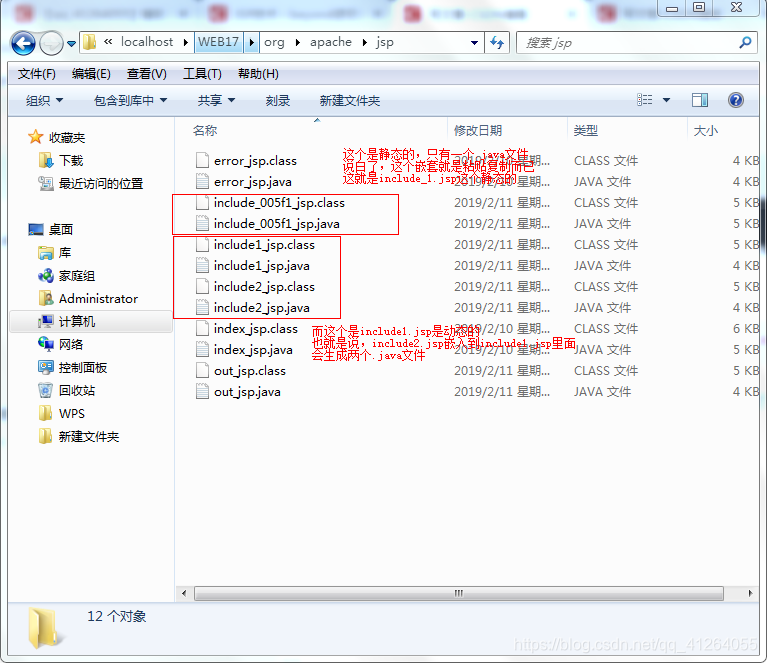一、jsp脚本和注释
jsp脚本:
1)<%java代码%> ----- 内部的java代码翻译到service方法的内部
2)<%=java变量或表达式> ----- 会被翻译成service方法内部out.print()
3)<%!java代码%> ---- 会被翻译成servlet的成员的内容
jsp注释: 不同的注释可见范围是不同
1)Html注释:—可见范围 jsp源码、翻译后的servlet、页面 显示html源码
2)java注释://单行注释 /多行注释/ --可见范围 jsp源码 翻译后的servlet
jsp注释:<%–注释内容–%> ----- 可见范围 jsp源码可见
<%@page import="java.util.*"%>
<%@ page language="java" contentType="text/html; charset=UTF-8" errorPage="/error.jsp" ispageEncoding="UTF-8" session="true" %><!-- 引入jstl核心库 -->
<%-- <%@ taglib uri="http://" orefix="q" %> --%>
<%-- <%@ taglib uri="http://" orefix="wsq" %> --%><!DOCTYPE html PUBLIC "-//W3C//DTD HTML 4.01 Transitional//EN" "http://www.w3.org/TR/html4/loose.dtd">
<html>
<head>
<meta http-equiv="Content-Type" content="text/html; charset=UTF-8">
<title>Insert title here</title>
</head>
<body><!-- 使用q库的标签 --><!-- <q:if></q:if> --><!-- 使用wsq库的标签 --><!-- <wsq:yy></wsq:yy> --><%@ include file = "/demo.jsp" %>wsqwsqwsq<!-- < %java 代码 % > --> <!-- 内部的java代码翻译到service方法的内部 --><%session.setAttribute("name", "qibao");int i=0;System.out.println(i); /* 会在控制台输出i的值 *//* List list = new ArrayList(); *//* java.util.List list = new java.util.ArrayList(); *///int y=1/0;%><!-- < %=java 变量或表达式 > --> <!-- 表达式,可以理解为最终有结果的东西 --> <!-- 会被翻译成service方法内部out.print(); --><%=i %> <!-- 这里会输出i的值为0,在页面输出 --><!-- < %!java 代码 % > --> <!-- 会被翻译成servlet的成员的内容 --><%!String sq = "hello qb";%><%-- 这是一个jsp注释 --%><!-- 这是一个html注释 --><%=sq %> <!-- 可以在页面输出sq这个字符串 --><h1>sq</h1>
</body>
</html>
二、jsp运行原理-----jsp本质就是servlet(面试)
jsp在第一次被访问时会被Web容器翻译成servlet,在执行
过程:
第一次访问---->helloServlet.jsp---->helloServlet_jsp.java---->编译运行
PS:被翻译后的servlet在Tomcat的work目录中可以找到
三、jsp指令(3个)
jsp的指令是指导jsp翻译和运行的命令,jsp包括三大指令:
1)page指令 — 属性最多的指令(实际开发中page指令默认)
属性最多的一个指令,根据不同的属性,指导整个页面特性
格式:<%@ page 属性名1= “属性值1” 属性名2= “属性值2” …%>
常用属性如下:
language:jsp脚本中可以嵌入的语言种类
pageEncoding:当前jsp文件的本身编码—内部可以包含contentType
contentType:response.setContentType(text/html;charset=UTF-8)
session:是否jsp在翻译时自动创建session
import:导入java的包
errorPage:当当前页面出错后跳转到哪个页面
isErrorPage:当前页面是一个处理错误的页面
2)include指令
页面包含(静态包含)指令,可以将一个jsp页面包含到另一个jsp页面中
格式:<%@ include file=“被包含的文件地址”%>
3)taglib指令
在jsp页面中引入标签库(jstl标签库、struts2标签库)
格式:<%@ taglib uri=“标签库地址” prefix=“前缀”%>
四、jsp内置/隐式对象(9个)
| 名称 | 描述 | 类型 |
|---|---|---|
| out | 用于页面输出 | javax.servlet.jsp.JspWriter |
| request | 得到用户请求信息 | javax.servlet.http.HttpServletRequest |
| response | 服务器向客户端的回应信息 | javax.servlet.http.HttpServletResponse |
| config | 服务器配置,可以取得初始化参数 | javax.servlet.ServletConfig |
| session | 用来保持用户的信息 | javax.servlet.http.HttpSession |
| application | 所有用户的共享信息 | javax.servlet.ServletContext |
| page | 指当前页面转换后的Servlet类的实例 | java.lang.Object |
| pageContext | JSP的页面容器 | javax.servlet.jsp.PageContext |
| exception | 表示JSP页面所发生的异常,在错误页中才起作用 | java.lang.Throwable |
(1)out对象
out的类型:JspWriter
out作用就是想客户端输出内容----out.write()
out缓冲区默认8kb 可以设置成0 代表关闭out缓冲区 内容直接写到respons缓冲 器
(2)pageContext对象
jsp页面的上下文对象,作用如下:
page对象与pageContext对象不是一回事
1)pageContext是一个域对象
setAttribute(String name,Object obj)
getAttribute(String name)
removeAttrbute(String name)
pageContext可以向指定的其他域中存取数据
setAttribute(String name,Object obj,int scope)
getAttribute(String name,int scope)
removeAttrbute(String name,int scope)
findAttribute(String name)
—依次从pageContext域,request域,session域,application域中获 取属性,在某个域中获取后将不在向后寻找
2)可以获得其他8大隐式对象
例如: pageContext.getRequest()
pageContext.getSession()
<%@ page language="java" contentType="text/html; charset=ISO-8859-1"pageEncoding="ISO-8859-1"%>
<!DOCTYPE html PUBLIC "-//W3C//DTD HTML 4.01 Transitional//EN" "http://www.w3.org/TR/html4/loose.dtd">
<html>
<head>
<meta http-equiv="Content-Type" content="text/html; charset=ISO-8859-1">
<title>Insert title here</title>
</head>
<body><%/* 使用pageContext向request域存数据 */request.setAttribute("name", "wsq");pageContext.setAttribute("name", "zhangsan", PageContext.REQUEST_SCOPE);pageContext.setAttribute("name", "lisi", PageContext.REQUEST_SCOPE);pageContext.setAttribute("name", "wangwu", PageContext.REQUEST_SCOPE);%><%=request.getAttribute("name") %><%=pageContext.getAttribute("name", PageContext.REQUEST_SCOPE) %> <!-- findAttribute会从小到大搜索域的范围中的name --><!-- pageContext域<request域<session域<application域 -->><%=pageContext.findAttribute("name") %><%pageContext.getRequest();pageContext.getOut();%>
</body>
</html>
四大作用域的总结:
page域:当前jsp页面范围
request域:一次请求
session域:一次会话
application域:整个web应用
五、两种jsp标签(静态,动态)的区别
#####都是在 *1.jsp 里面嵌套 *2.jsp
动态:
<jsp:include page="/include2.jsp"></jsp:include>
//include1.jsp
<%@ page language="java" contentType="text/html; charset=ISO-8859-1"pageEncoding="ISO-8859-1"%>
<!DOCTYPE html PUBLIC "-//W3C//DTD HTML 4.01 Transitional//EN" "http://www.w3.org/TR/html4/loose.dtd">
<html>
<head>
<meta http-equiv="Content-Type" content="text/html; charset=ISO-8859-1">
<title>Insert title here</title>
</head>
<body><h1>this is an include1.jsp</h1><!-- 包含include2.jsp --><jsp:include page="/include2.jsp"></jsp:include>
</body>
</html>
//include2.jsp
<%@ page language="java" contentType="text/html; charset=ISO-8859-1"pageEncoding="ISO-8859-1"%>
<!DOCTYPE html PUBLIC "-//W3C//DTD HTML 4.01 Transitional//EN" "http://www.w3.org/TR/html4/loose.dtd">
<html>
<head>
<meta http-equiv="Content-Type" content="text/html; charset=ISO-8859-1">
<title>Insert title here</title>
</head>
<body><h1>beyondwsq</h1>
</body>
</html>
静态:
<%@ include file="/include_2.jsp" %>
//include_1.jsp
<%@ page language="java" contentType="text/html; charset=ISO-8859-1"pageEncoding="ISO-8859-1"%>
<!DOCTYPE html PUBLIC "-//W3C//DTD HTML 4.01 Transitional//EN" "http://www.w3.org/TR/html4/loose.dtd">
<html>
<head>
<meta http-equiv="Content-Type" content="text/html; charset=ISO-8859-1">
<title>Insert title here</title>
</head>
<body><h1>this is an include_1.jsp</h1><%@ include file="/include_2.jsp" %>
</body>
</html>
//include_2.jsp
<%@ page language="java" contentType="text/html; charset=ISO-8859-1"pageEncoding="ISO-8859-1"%>
<!DOCTYPE html PUBLIC "-//W3C//DTD HTML 4.01 Transitional//EN" "http://www.w3.org/TR/html4/loose.dtd">
<html>
<head>
<meta http-equiv="Content-Type" content="text/html; charset=ISO-8859-1">
<title>Insert title here</title>
</head>
<body><h1>xxxxxxxxx</h1>
</body>
</html>
接下来,咱们来看一下源码:
E:\Web后端\WEB12_Http&Tomcat\WEB12_Http&Tomcat\资料\apache-tomcat-7.0.52\work\Catalina\localhost\WEB17\org\apache\jsp
include1.jsp跟include2.jsp是动态的嵌套


1)页面包含(动态包含):<jsp:include page=“被包含的页面”/>
(静态包含):<%@ include file=“被包含的页面” %>
2)请求转发:<jsp:forward page=“要转发的资源” />
也就是从*1.jsp可以跳转到要转发的资源位置



方法)




方法)
)





![[转]一个清华计算机博士生的退学申请](http://pic.xiahunao.cn/[转]一个清华计算机博士生的退学申请)



